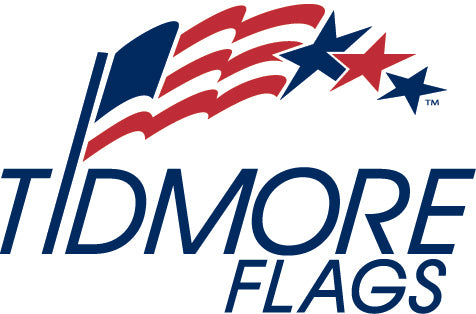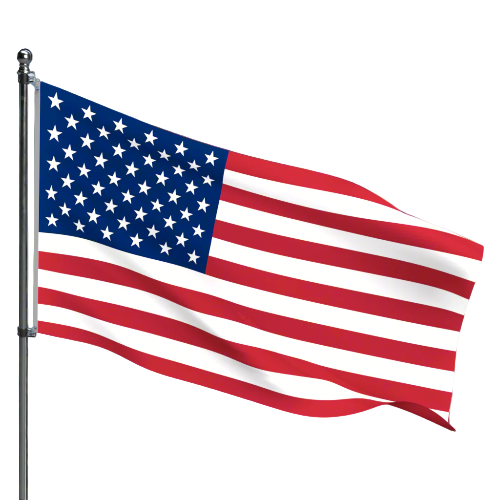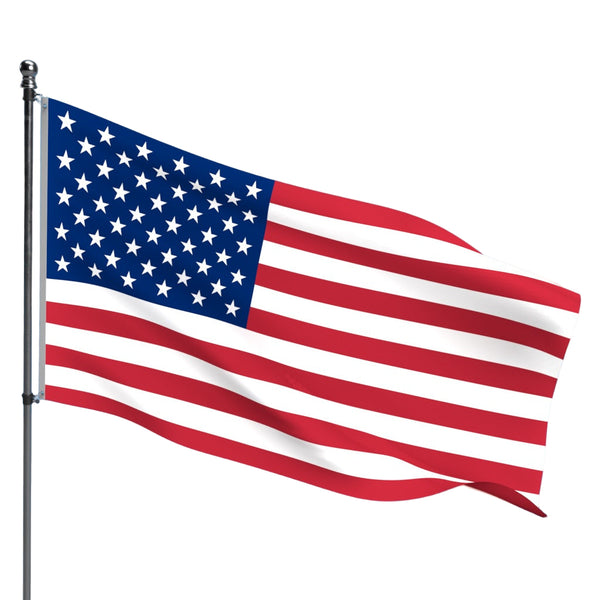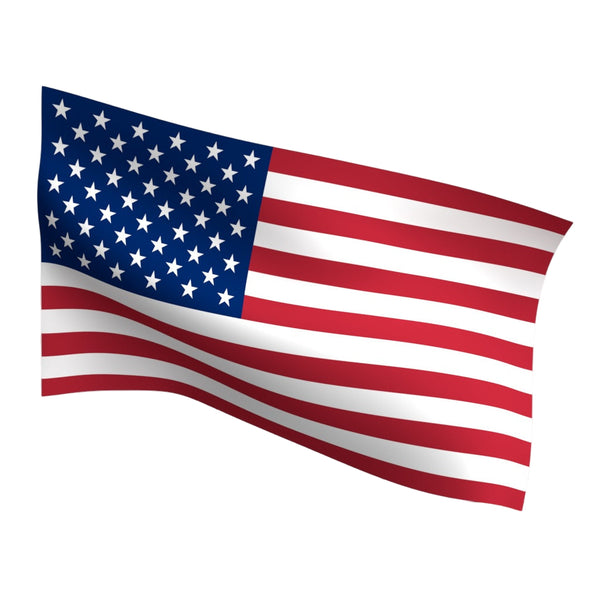The $12 Flag vs. the FMAA-Certified Standard: Which One Truly Deserves Your Pole?

Share
You’ve seen the ads: “Best American Flag! Prime Shipping! Under $20!” The thumbnails look glossy. The reviews look… okay-ish. And yet, a month after it hits your porch bracket, the red turns pink, the blue goes gray, and the fly end shreds. Meanwhile, your neighbor’s U.S. flag—Made in the USA and FMAA-certified—still flies crisp and bright.
If you’ve ever wondered “FMAA certified vs Amazon flag—what’s the real difference?” or searched for the best American flag test before you buy, this guide is for you. Below, you’ll find a real-world story, a simple checklist, and plain-English answers so you can choose a flag you’ll be proud to raise all year.
A 90-Day Story (Reality Check)
A customer named David called into Tidmore Flags after a summer of trial and error. In April, he bought a bargain U.S. flag from a giant marketplace. By Memorial Day, it was already fading. By Flag Day, the fly end split across two stripes. On July 4th—the one day he wanted the display to look its best—he noticed loose seams in the canton. He was annoyed, but not surprised.
In August, he switched to an FMAA-certified U.S. nylon flag. Same pole, same porch, same wind. Ninety days later, the color still popped. The fly end was intact. The header and grommets were solid. “I should’ve bought this first,” he said. Consider this your nudge to do exactly that.
.
What “FMAA-Certified” Means (Not Just a Sticker or Tag)
FMAA stands for Flag Manufacturers Association of America. Its mark appears on U.S.-made American flags that meet standards for origin, materials, construction, and colorfastness. In practice, that means:
- Origin: Cut, sewn, and finished in the United States.
- Materials: Proper outdoor nylon or 2-ply polyester, real canvas headers, and heavy-duty grommets.
- Construction: Lock-stitched seams, double-folded fly ends, and box-reinforced corners.
- Colorfastness: UV-resistant dyes that hold their red and blue under sun.
A marketplace title can say anything; FMAA certification is proof. When you compare FMAA certified vs Amazon flag, you’re comparing verified standards to whatever shipped that day.
The “Best American Flag Test” (6 Fast Checks)
You don’t need a lab—just your hands and eyes. Here’s a quick, practical test before you commit.
- Fly-end reinforcement: Look for a double-fold hem with four rows of lock-stitching; box-stitch at the upper corner is a plus.
- Header & grommets: A sturdy canvas header and heavy grommets keep loads off the fabric.
- Fabric match: Nylon (bright, quick-dry) suits most homes; 2-ply polyester suits windy/coastal sites.
- Dye quality: Color should feel rich and deep, not chalky; poor dyes go pastel quickly.
- Star field & stripe accuracy: Clean, consistent rows and seams signal overall quality.
- Origin you can verify: “Made in USA” with the FMAA mark beats vague wording.
Why Cheap Marketplace Flags Fail Early
Bargain flags cut cost where it hurts most:
- Thin fabric → fast fray at the fly end.
- Loose or chain stitching → runs if a single thread breaks.
- Weak headers → grommet tear-outs.
- Low-grade dyes → pinkish reds and grayish blues by month two.
- Inconsistent specs → one okay flag, the next a dud.
Ironically, replacing a cheap flag two or three times a year often costs more than buying one quality, FMAA-certified flag upfront—while your display looks worse the entire time.
Where FMAA-Certified Flags Shine
- Residential porches: Nylon flies in light breeze and resists quick fade.
- Wind corridors/coastal homes: 2-ply polyester carries more mass and shrugs off gusts and salt.
- Schools, churches, civic buildings: Certification matters for public trust and ceremony.
- Year-round flying: Better dyes + better stitching = fewer replacements.
Question for You
Would you rather replace a bargain flag three times a year—or raise one great flag and focus on everything else?
How to Buy Like a Pro (Even on Your First Try)
- Match material to wind: Nylon for most homes; 2-ply polyester for sustained wind.
- Size to pole height: 3′×5′ for 15–20′ poles; 4′×6′ for 20–25′; 5′×8′ for 25–30′.
- Inspect the build: Double-fold fly end, four rows of lock-stitching, box-reinforced corner, canvas header, heavy grommets.
- Look for the mark: The FMAA label ends the “fmaa certified vs amazon flag” debate.
- Consider a kit: Tangle-free spinning pole + heavy bracket reduce wrap and stress.
One Screenshotable List: 9-Point Buyer’s Checklist
- FMAA-certified label
- Made in the USA (not just “designed”)
- Material listed (nylon or 2-ply polyester)
- Double-fold fly end
- Four rows of lock-stitching
- Box-stitch corner reinforcement
- Canvas header + heavy grommets
- UV-resistant dyes
- Size matched to pole height
The Best American Flag Test You Can Do at Home
- Grip & pull: Tug the fly end; lock-stitching shouldn’t ladder.
- Light check: Hold fabric to a window; weave should look tight, not gauzy.
- Water mist: Nylon/Polyester should shed and dry evenly without seam sag.
- Color watch: After a week of sun, good dyes don’t go chalky.
- Hardware try-out: Raise/lower a few times; good headers don’t twist, grommets hold shape.
Beyond Fabric and Thread (Why It Matters)
Choosing Made-in-USA, FMAA-certified isn’t only about durability. It’s about craftsmanship you can inspect, a supply chain you can trust, and symbolic integrity for homes, schools, and memorials. Your flag represents more than a deal of the day. It should look like it.
Common Myths—Debunked
- “All flags fade fast.” No. Quality dyes and fabrics slow UV fade significantly.
- “Polyester is always better.” Not always. Nylon is best for most porches; 2-ply poly shines in wind.
- “Chain stitching is fine.” Not at the fly end. Lock-stitching prevents unraveling.
- “Lots of reviews = good flag.” Reviews aren’t standards. Certification is.
The One Flag We Recommend Most
For most homes, start with a 3′×5′ FMAA-certified nylon U.S. flag. If you live in steady wind or near the coast, step up to 2-ply polyester. Pair with a tangle-free spinning pole, a heavy bracket, and add a solar or ground light if you fly after dark.
FAQ: FMAA Certified vs Amazon Flag
Is FMAA just a label?
It’s a certification verifying the flag is made in the USA and built to recognized standards (materials, construction, and colorfastness).
How long should a good flag last?
It depends on wind and sun. Many homeowners get 3–6+ months per nylon flag; 4–8+ months with 2-ply polyester in windy zones. Rotating two flags extends life.
Nylon vs polyester—what’s “best”?
Nylon for most porches (light wind, vivid color). 2-ply polyester for sustained wind and coastal abrasion.
Single biggest durability signal?
A double-fold, lock-stitched fly end (four rows) with a box-reinforced corner and a canvas header with heavy grommets.
Can I repair a frayed fly end?
Yes—trim and re-hem early to extend life. If seams or color are gone, retire with dignity and replace.
Final Thought
Imagine late fall: clear sky, evening light on crisp stripes—no fray, no sag, color still true. That’s the difference between a bargain listing and a standard you can stand behind.
Ready to raise your standard? shop TidmoreFlags.com for FMAA-certified American flags in nylon and 2-ply polyester, hardware that fits, indoor presentation sets, and lighting for respectful night display. Need help matching fabric to your wind or sizing to your pole? Our team will guide you so you can retire with dignity and raise with honor—every time.




